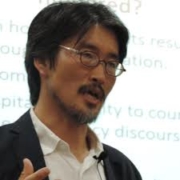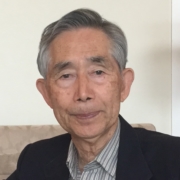Today we talk about war and children in Japan. My guest is Sabine Frühstück, a Professor of Modern Japanese Cultural Studies at the University of California, Santa Barbara, where she also directs the East Asia Center.
She has published a new book called Playing War: Children and the Paradoxes of Modern Militarism in Japan. It is a cultural history of the naturalized connections between childhood and militarism.
In the book, Sabine analyzes the rules and regularities of war play, from the hills and along the rivers of 19th century rural Japan to the killing fields of 21st century cyberspace. It is a timely book that addresses the red-hot debates in Japan over its imperial past, its imposed pacifism, and its creeping militarization today.
Citation: Frühstück, Sabine, interview with Will Brehm, FreshEd, 86, podcast audio, September 11, 2017. https://www.freshedpodcast.com/fruhstuck/
Transcript, translation, and resources:
Will Brehm 2:10
Sabine Frühstück, welcome to FreshEd.
Sabine Frühstück 2:13
Thank you so much for having me.
Will Brehm 2:15
You have a new book out called ‘Playing War’ and you are looking at the history and contemporary culture of children and the connection to military in Japan. What is this connection between the military and children? How are children militarized?
Sabine Frühstück 2:34
I believe that historically and contemporarily, one of the surprising stories to tell is that children and childhood as a metaphorical, as a symbolic concept, and militarism and military are very closely connected in the sense that we have theories about children being quasi naturally drawn to war and to playing war in particular. And on the other hand, we have a military, particularly during the modern period until 1945, that exploited children and the figure of the child in various ways in order to advance Japanese militarism in Asia. And in Japan, of course, this whole relationship is interesting, because we think of post-1945 Japan as pacifist and anti-militarist, and correctly so. But in recent years – the last 10 years – the current military, the Self Defense Forces, is increasingly tapping into children’s culture, and is utilizing the figure of the child in order to favorably mold its public image.
Will Brehm 3:57
So let’s go through the history a bit here. So before we get to the post-1945 era after World War II, and even in the last few years, like you said about the Self Defense Forces, let’s talk about Imperial Japan. What were you looking at when you researched Imperial Japan to look at the connection between children and the military?
Sabine Frühstück 4:20
The material itself is actually incredibly interesting and varied. It is really around 1900 that children’s books, children’s magazines, all kinds of other materials that are specifically created for children on the basis of a new notion of children deserving their own popular culture, their own mass culture, their own readings, their own images, and so and so forth. So for that part of the book, I looked at exactly these materials: children’s books, children’s magazines, picture books, guides for mothers and families, on how to raise children, on how to mold their emotions, on all aspects that have to do with child education, including play. And so I got to look at a lot of interesting images. I looked at soldiers’ memoirs that were written for children, memoirs of the war experience that were written for children in Japan with an eye on the idea that Japanese children would of course want to know how children in parts of the Empire live.
Will Brehm 5:39
And so what did you find?
Sabine Frühstück 5:41
A number of things were particularly interesting to me. One is that the rhetoric of children in Japan being particularly lucky because they get to grow up in Japan was one conversation that one can trace across different children’s media. Whereas children in Manchuria, children in other parts of China, in other parts of Asia, deep into the 1930s and early ’40s, were represented as being very poor. Were represented as not being able to go to school and learn. Not having enough to eat and so on and so forth. So that was one particular theme that was very prominent. Another one was images, but in memoirs as well. The idea and the depiction of soldiers with children, of Japanese soldiers with children in the South Seas, in Manchuria and other parts of the Empire. And they were always represented as being in entertaining conversations with these children. It was always sort of amicable kind of encounter; the soldiers give candy to the children, caramels in the case of Japanese soldiers, in particular at the time they chat with children. They report the children come after them to talk to them. So that whole notion of Japanese soldiers behind the front lines all over Asia encountering children that were interested in them and with which they struck up friendships, was also something that was very prominent. And there’s a number of ideas that I think inform in these images. One is the preliterate children, but perhaps children up to the age of 12, 13 or so in Japan needed to be told that their fathers, their brothers, their uncles, all those soldiers went abroad, and were really nice to these other children there, just like they would have been at home. So we’re in a setting that is incredibly violent – it’s war, it’s an imperialist war – but children at home very clearly needed to be told that the soldiers were the same good men that they were at home. And one way to show that was to picture them with children in various places across the Empire. Another kind of interpretation I came up with there is that the depictions of children are used there as signaling that these soldiers – and signaling not just to the children in Japan, but to their, perhaps mothers, to teachers, other people who read to these children who couldn’t read yet, or looked at the pictures and picture books together – to convey to them that they really are the future. And when you depict children, it’s already about peace building, nation building, a future together. And so there are lots and lots of utterances by soldiers in memoirs, by other authors in children’s books that essentially suggest that these soldiers were there to rescue the children, to protect the children, and also to forge a relationship between children and the Empire, and children in Japan, because this would be the generation of the future. And so there’s a lot of language about “children need to become friends for future peace”.
Will Brehm 9:44
And it would assume that Imperial Japan would still be around. The Empire would still exist in that future.
Sabine Frühstück 9:53
Yes, absolutely. And that’s the interesting thing: we have a lot of scholarship about indoctrination and propaganda. And one of the things I tried to do in this book is draw the net much wider, and not just look at the materials that were published by governmental agencies, but down to, or as far away from that as children’s books that utilize the figure of the child as vulnerable, as innocent, as malleable, as a symbol of future peace. And does not actually say that the Japanese Emperor will be there forever, but not talk about the Emperor, not talk about the war. The language is already about the peace that is right after the war. And so for these younger children, the messages are not about “Japan will win the war”, or “you need to be become a brave soldier” or something like that, primarily. It’s about “you really are the little people who will build the peace afterwards”. And the whole political structure, the reason why the soldiers are there in the first place, the possibility that these same soldiers might have just killed the parents of these Chinese children, for instance, that’s just not in the picture.
Will Brehm 11:28
You were saying that children were conceptualized at this period as being innocent and vulnerable. Was this a new way to conceptualize? For instance, was this something that was found in Imperial Japan but not before?
Sabine Frühstück 11:42
That’s a very complicated question. I looked into the material of the second half of the 19th century and the late 19th century. What we see is lots of different beginnings of a modern notion of childhood. And when you ask, “What could possibly be this beginnings?”, there are a number of things. One of the key dates that I believe to be essential is 1872, which is the year when two laws came into being. One was mandatory military service for 20 year old young men and up. And the other was mandatory elementary school for both boys and girls. And so it’s really in 1872, one could argue, at least superficially, when the Japanese state says, “The child needs to go to school and be trained, and it can’t be left to the parents or to families. It can also not be left to class affiliation of children of whether they get any formal education at all.” And at the same time, the state declares that definitely, for a 20 year old boy, that’s the end of childhood. Because that’s the time when young men needed to undergo the military physical exam and potentially be drafted for military training. Actually, a small portion of men were drafted at that time, but that was at least the legal framework to allow that. But then there were a lot of other new laws and legal frameworks that essentially cast the child as a separate entity from an adult. And not only to be controlled – that was very important, the control of the child – but also to be protected. And so one can discuss what was the primary motivation and so on. But there’s a number of things that signal that new concept of the child as also being vulnerable and inherently different from an adult person. For instance, in addition to the mandatory elementary schooling, we have the first child labor law in 1911. We have foundling laws, child welfare laws. And, this changes gradually, but in late 19th century Japan, a child was defined essentially as child up to the age of 13. And when I say that, I mean that, for instance, criminal law treated the child of the age of 13 very different from a younger child. Or child labor laws or welfare laws. So for instance, a child under the age of 13 was to be protected by public institutions if it was an orphan. But the expectation was very clearly, according to the law at least, that once a child was 13, they were supposed to be capable of taking care of themselves if need be. And so there’s an advancing and intensifying notion of the child being a vulnerable individual that needs to be protected, that needs to be trained, educated, nurtured, and also controlled.
Will Brehm 15:23
And then when those children grew up and they were supposed to enact this sort of peace, as you were saying, what actually happened? Imperial Japan obviously did not last after World War II, so what happened to the connection between the military and the child or childhood in the post-1945 world of Japan?
Sabine Frühstück 15:50
There are wonderful materials from the occupation period, the early 1950s, when a number of sociologists did the first study on how children experience the occupation, and obviously, to the degree possible, how they see their occupation in comparison to the war time. And so what these social scientists did was basically put out a call to children, and say, “send in something you write up on how you see the occupation and what your experiences of soldiers and war and so on”. And so, this is really the first time when we have a fairly, of course methodologically there are some problems with a study like that, but by contemporary standards, but this is the first data set we have where children are asked and respond to a particular question about how they feel about it, and what they see. And so a lot of these children are very disappointed with the fact that there are still so many soldiers around, even though the war has supposedly ended. And the children are really the last ones. And I’m not saying that all of them said things like that, but far into the 1950s, one still has utterances of children where they proudly point to a map and say, “Well Japan used to be this big, and too bad that Japan lost the war”, and so on. So one has to consider, of course, these are children who hadn’t known anything but wartime, and came out of it fully permeated by this notion of Japan being an incredibly great empire, and then they lost the war. The adults, particularly teachers, and other kinds of public commentators, incredibly swiftly shifted to an anti-militarist, pacifist kind of perspective. And so we have in magazines and newspapers, commentaries from teachers, for instance, who watched children playing war in the street and say, “Oh, parents, you need to watch out. Children need to be educated properly and need to be educated to become proper pacifists, and so on and so forth.” And the interesting thing here is that this is a very quick move from one notion of what children should be encouraged to do to another. And children do not make that switch as fast, I think is an accurate perspective. And so we have accounts of children continuing the war games that they have played during the war, and a lot of negative commentary and critical commentary about that from teachers. In children’s magazines and children’s books, the war almost immediately disappears. And so I’ve looked at decades of children’s books, and it’s very clear that the same publishers who, a few years earlier had promoted war games played by children as an excellent preparation for becoming soldiers, for instance, now were intent on producing little pacifist child readers. So we have a mixed bag in the 1950s and ’60s, and I think particularly among children, because they are the ones who have grown up only during the war.
Will Brehm 19:54
So this change between this military ethos to an anti-military ethos in a very short period of time, and it impacted children, like you said, pretty drastically. But were children still conceptualized in the post-1945 era as being vulnerable and innocent like they were in the Imperial era?
Sabine Frühstück 20:18
Absolutely. But under a new regime, so to speak. Now they were vulnerable and innocent, and were as such to be trained to become pacifist adults. And so there’s a lot more discourse about how certain kinds of games, for instance, are dangerous to children. I’ve looked at this over decades. But even in the 1920s, there are newspaper reports about how parents do not properly take care of their children and sometimes they fall into a river and drown while playing, for instance. And so that kind of concern that mothers, in particular, need to be watching out for children during the day and make sure that they don’t engage in any dangerous activity, is exacerbated tremendously in the post war period, both in schools as well as in public life in general. For that, it’s important to consider that even in the early 20th century, and into the war period, children were out and about all day, and many of them did who knows what during the day if they were not working. And so that changes drastically in post war Japan.
Will Brehm 21:44
In what ways?
Sabine Frühstück 21:45
Well, that mothers are much more pressured to conceptualize themselves as primary caretakers of children. That was not a mainstream idea. Up to the post war period, it was very much promoted since the Meiji period. But in practice, that wasn’t the case. We have multi-generational families. Whoever could took care of the children or watched the children. Relatively young children watched even younger children of just a few years of age, even babies. And in the post war period, obviously, also in the wake of the economic rise of Japan and the full embrace of the middle class as ideal lifestyle and also as one that was available to ever more people. School education became much more routine and normalized across the entire population, not just elementary school education, but also secondary school education. And so we have relatively dramatically different ideas about how children should be taken care of in the post war period. And that also becomes partly the task of schools – to take care of children for ever longer hours in a post war era.
Will Brehm 23:14
And was there a baby boom in the post war Japan era?
Sabine Frühstück 23:17
Yes, there was.
Will Brehm 23:19
Today we hear often about the declining birth rate in Japan. How is that impacting the notion of childhood today?
Sabine Frühstück 23:29
That’s a very important question. And one can probably say that children, at least throughout the modern period, and up to the current day, have always been a big topic for Japanese media and public life in general. What these media and other commentators talk about when they talk about children has changed dramatically. Obviously, in the high growth period, up to the 1980s, one key discussion – that continues to this day, but it’s no longer I believe, as prominent – is, “how much pressure is appropriate for children? How much pressure to succeed in schools?” And so we have an enormously prominent debate about, “Do we, in Japan, discipline our children too much? Do we pressure them too much to succeed? Is it harmful to children to expect too much of them in terms of academic achievements?” And up to the ’80s, other aspects of that discussion were bullying at school and then also child suicide. The child suicide rate in Japan is one of the highest around the world, and partly, the education system has always been made responsible for that. In the late 1990s, that conversation doesn’t go away, but it shifts somewhat due to a really very small number of quite horrific cases of children killing other children. And that was a huge shock to Japanese society, and these cases triggered wide-reaching discussions about, “What is wrong about our society? What is wrong about our education system? What’s happening to our children? How could we not see this coming?” And one contextual frame for that discussion was the rising number of so-called “shut ins”, the majority of whom are boys who hardly leave the room or their parent’s house and don’t want to interact with anybody socially other than through the internet, and computer networks. And so the alienation of adult society from children and the alienation of children from the rest of society has become the current new theme. And, as you say, the other one is the dramatically declining birth rate in Japan. And as somebody who has been visiting Japan for almost 30 years now, it’s really….. in public, be it urban or rural – although I tend to spend more time in urban Japan – it’s quite noticeable that even on weekends, when it’s Sunday is usually family day or “daddy day”, one sees really very few parents with children. And if one does, it’s usually with one child. And so that’s certainly an issue that is very much on the forefront of discussions about childhood in Japan today.
Will Brehm 27:14
And so today, what is the connection between childhood and children in the military?
Sabine Frühstück 27:20
I’ve written another book prior to ‘Playing War’ that is an ethnography of the Self Defense Forces. And so for the last 20 years, looked at reporting about the Self Defense Force and also what they publish in terms of public relations materials, in terms of recruitment materials. And one very interesting development – and interesting partly because it’s new, but partly also in light of the declining birth rate – one interesting element is the fact that the Self Defense Forces now have tapped into or do tap into children’s culture in a way they have never done before. So it’s an incredibly interesting development to see that at the very moment when children become fewer and fewer, the military sort of rediscovers them as carriers of positive images about the Self Defense Forces and as legitimatizers of the Self Defense Forces’ missions. So it’s obviously not the connection that the Imperial Army made, or publishers made of the Imperial Army with children in Imperial Japan, it’s not the same kind of connection. But what is strikingly similar is the fact that the public relations apparatus of the Self Defense Forces have discovered that it’s incredibly useful and productive to first appeal to children as their public. Because very clearly, they see what public relations specialists at the being of 20th century saw. Namely, that children prior to the age of 12 or 14 are open to all kinds of messages; they are the ones that can still be “educated”, in quotation marks, even if their parents might be anti-military or anti Self Defense Forces, or disinterested in them. So what they have begun to do is produce little anime with children in prominent positions where, for instance, one you will find on the website of the Defense Ministry of three children who sit around a table. One of the children draws a bird and this bird becomes alive. And the father is a member of the Self Defense Forces. The mother, in fact very unrealistically, is a housewife. And so this bird becomes the educator of these children about what the father actually is doing in the Self Defense Forces. And so it’s the kind of imagery that would appeal to a child, that’s one aspect of it. But it also has children in it. So children carry something for the military that is non-threatening. They are curious. They are innocent. There’s nothing negative and nothing violent about children. And so they are used by the military public relations people in order to paint a particular kind of image of the Self Defense Forces that is conveyed to both children and adults.
Will Brehm 31:02
There’s a big debate right now in Japan about militarization. Basically, the idea that, yes, it’s a pacifist country and in the Constitution, there’s an article – article nine – that states that Japan can’t have a military for external use. And so they have this Self Defense Forces as you’ve been calling them. And it’s very different than most other countries in the world. But there is a debate now about getting rid of article nine, or amending it in a way to allow Japan to have more of a traditional military as people probably would understand it. But do you think that these images and the recruitment material that the Self Defense Forces has recently produced, as you just been talking about, do you think this will impact the debate over article nine: whether or not Japan should amend its constitution to allow for a traditional army rather than the Self Defense Forces?
Sabine Frühstück 32:08
Well, that’s obviously difficult to say whether it’s going to impact that, but it’s certainly a product of that very conversation. You will probably recall that 10, 20 years ago, and at several moments since the foundation of Self Defense Forces, there have been discussions about article nine. And I believe that the current strategy of the Abe administration, as well as the Defense Ministry, in different kinds of ways, is different from previous strategies. The kind of public relations material I’ve just described will, and does, I believe, help to create positive feelings towards the Self Defense Forces in anybody who is listening. What does that mean, what kind of impact will it have, is unclear. I can imagine, given the very lack of history education about Imperial Japan, the currently young generation who is eligible to join the self-defense forces have … I mean, the younger generation is sort of accepting the possibility of the Self Defense Forces eventually going to war in some configuration as inevitable. And I think that’s partly because, first of all, they haven’t been paying attention to Japan’s history enough. And more importantly, I think, the older generation, the sincerely pacifist older generation – be it teachers, be it parents, be it other kinds of public figures – have, in my mind at least, really failed at explaining to the newer generations what it is about pacifism and anti-militarism that is so important. When you listen to media in Japan, at least for the time I have done so, most of the discussion is about “Japan is different. Nobody else has an article nine”, and eventually that justification of war, “the war was terrible, atomic bombs were terrible, and that’s our responsibility” has become marginalized, partly because the current middle age generation has not done a good job. It’s a little bit like explaining why democracy is the best system one can have. Nobody does that until it’s threatened. And I think that’s the case with pacifism in Japan to a large degree. But one thing I always feel like asking the administration and the defense ministry is, “Even if the current discussion in whatever way it plays out, and the current public relations material and campaigns create that positive feeling towards the military, I wonder where these young men will come from, who are then supposed to join the Self Defense Forces and do that war making.” It’s one thing to say, “Oh, the Fuji live-fire exercise, that’s really cool. And we have this and that plane, and the Self Defense Forces do this and that.” But it’s quite another to then say, “Okay, and I’m willing to kill somebody for it and risk my life for that coolness.” And I think that is something that politicians tend to overlook. And also, I think the military elite tends to overlook, because leaders tend to believe that if you only train them properly, they will do what they are trained to do. But the big question here is who is going to join the military with such fancy ideas about what the military can now do or might soon be able to do.
Will Brehm 36:47
Well, Sabine Frühstück, thank you so much for joining FreshEd.
Sabine Frühstück 36:52
Thank you so much.
Playing War in Japan









